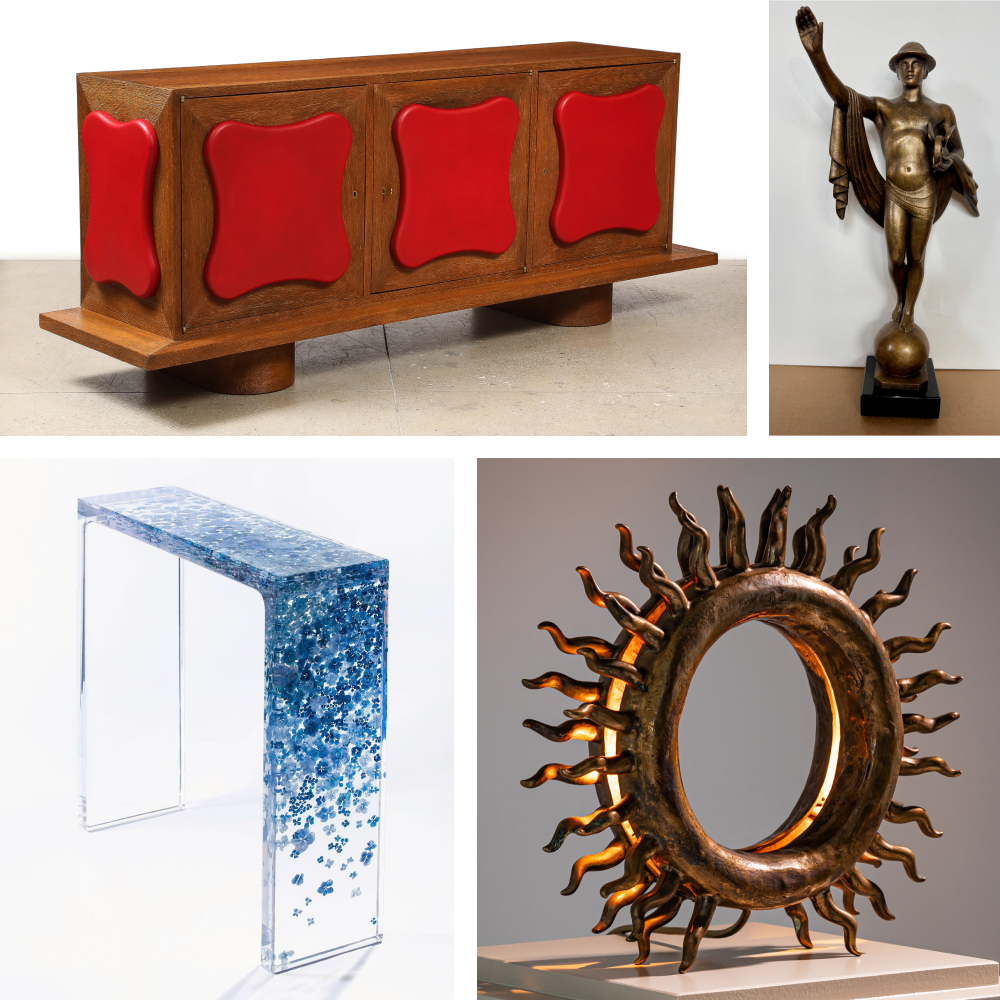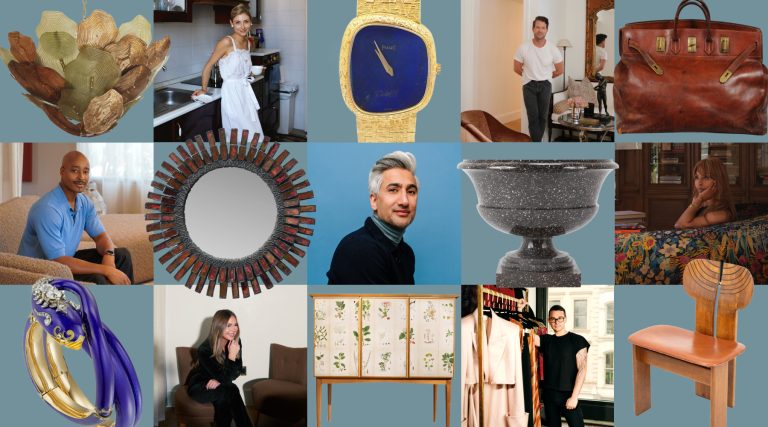November 2, 2025Salon Art + Design is returning to New York’s Park Avenue Armory from November 6 to 10. Nicky Dessources, in her second year as executive director, had reason to worry that tariffs and travel complications might hurt the fair, but she hasn’t seen that happen. “This year, we have a really strong showing of foreign galleries,” she says. “They include Charles Burnand from London, returning after a hiatus, and Sceners, coming from Paris for the first time. There are also more dealers showing vintage and contemporary pieces together and embracing the conversation that happens between the two.”
Converso

Chicago-based Converso will be showing a number of works from the New Hope studio craft movement, named for the Pennsylvania town where George Nakashima, Paul Evans and other design masters flourished in the postwar years. Evans’s mastery will be seen not only in his furniture but also in a chandelier, cast-iron bowls, brass candleholders and a striking metal-patchwork box. And Alexander Calder, a Pennsylvanian by birth, will be represented by a selection of tapestries produced in small editions in the 1970s.
Also making an appearance will be a monumental sounding chandelier, created very far from New Hope by Arizona utopianist Paolo Soleri. But the biggest item will be a circa 1979 living room suite in oak, wenge and rosewood carved by Phillip Lloyd Powell, a Pennsylvanian who worked for Evans early in his career before shifting to wood from metal.
Donzella Ltd.


Donzella will travel uptown from its midtown Manhattan gallery with a very linear and minimal Pietro Chiesa cabinet and a very curvy and amorphic Renzo Zavanella sofa. The cabinet, designed for Fontana Arte around 1939, and the 1948 sofa, in red, blue and yellow leather, “are sort of polar opposites,” says gallery owner Paul Donzella, “and I thought it could be fun to play up that tension. I love the idea of making incongruous colors and lines live harmoniously in this twelve-by-thirty-foot space.” Among the other vintage pieces in the Donzella trove is a circa 1942 Trèfle sideboard by the nonpareil Jean Royère, made of sand-blasted oak with large red leather panels. Contemporary works include a cast- and polished-brass coffee table by Jean Arriau and a glazed-stoneware Cloud sculpture by Chris Gustin, both of which resemble natural formations.
Twenty First

Twenty First’s booth, designed by Paris-based scenographer Jean de Piépape, will resemble a refined collector’s living space. Among the offerings will be Alexandra Mocanu’s Tapestry N138, which is made of wool woven onto canvas so meticulously that the work appears to be a painting, and Erwan Boulloud’s Écailles Enfilade, a burnt-wood cabinet encased in polished-brass marquetry, embodying the duality of precision and rawness. Then there’s RoWin’Atelier’s long, curvy and asymmetrical Conq sofa, its soft alpaca arms adorned with mirror-polished-bronze insets. And on the wall behind it is J. McDonald’s Dichasium mirror, made largely of 3D-printed sand, which takes its name from a botanical form of branching that’s echoed in the mirror’s frame.
Milord


Milord, a Montreal gallery focusing on mid-century works, is coming to Salon for the first time. One of its standout offerings is a rare disc-shaped bar cabinet by Paul Evans. It’s as much a wall sculpture as a useful piece of furniture, “but I could see James Bond serving a martini from it,” says gallery owner Francis Lord. If you’re more into squares than circles, you might prefer Evans’s skyline dining table, an assemblage of polychromed and patinated steel blocks supporting a glass top. It is unmistakably the work of a man exploring the possibilities of metal, even as his Bucks County, Pennsylvania, neighbor George Nakashima was doing the same with wood.
Karl Kemp

“We have so many lovely pieces coming to Salon,” says Karl Kemp gallery director Crawford Bray. These include a pair of Triennale chairs by Gio Ponti. Designed in 1953, they represent a radical deconstruction of the wingback chair, with the normally hidden wooden frame exposed and the usually ample upholstery reduced to small, suspended cushions.
Another piece, the Civa table lamp — by the French-Swiss duo Elizabeth Garouste and Mattia Bonetti, who were active in the late 20th century — borders on the surreal. “More sculpture than useful object,” according to Bray, it consists of two cast-bronze versions of the sun but barely throws off any light.
Hostler Burrows

New York– and Los Angeles–based Hostler Burrows will be showing mostly contemporary work, much of it from Scandinavia. Highlights include an illuminated carved wall sculpture by the Danish design studio Egeværk that evokes dusk in that country’s winter. Meanwhile, a sculptural glazed-porcelain still life by Israeli-American artist Anat Shiftan, titled Flora Forest, and Orchard in Yellow and Green, evokes warmer climes. A series of pyramidal bronze lamps designed by Shawn Henderson and Rupp Studio is paired with a collection of shades created by Bogotá’s Verdi studio. “Each shade weaves yaré, a resilient vine native to the Colombian Amazon, with metallic threads, capturing the tension between the organic and the refined,” says Rupp Studio’s Mike Rupp. In the vintage category is a circa 1970 rosewood, brass and concrete coffee table by Norwegian architect Erling Viksjø.
Galerie Gmurzynska

Sixty-year-old Galerie Gmurzynska takes a scholarly approach to exhibitions. At this year’s Salon, it will be exploring the uses and meanings of the grid in 20th-century art. Its booth will contain one of the most dramatic items in the entire fair: an approximately 8-by-13-foot assemblage by the sculptor Louise Nevelson. Part of her “City Series” (1974), it explores — and explodes — the Manhattan street grid. Also on view will be Vocable d’homme (1957), from the prominent Chilean-born artist Roberto Matta’s series of paintings of deconstructed cubes; Yves Klein’s F 48 (1961), one of his earliest and rarest “Fire Paintings” (technically, scorched paper over canvas), which attempted to find creation in destruction; and Robert Indiana’s Sixth State, a rare work on plywood from the period when he was redefining American painting along with Ellsworth Kelly, Agnes Martin and Jasper Johns. Dating from before Indiana’s engagement with words, it can nonetheless be read as full of personal and cultural associations.
Charles Burnand Gallery


A massive, 20-foot-long solid-cast-bronze dining table by Korean artist Myungtaek Jung will anchor the outpost of the Charles Burnand Gallery, which is based in London’s Fitzrovia neighborhood. Mounted overhead, Ian Milnes’s Midnight Tulip, a monumental light installation in the form of a flower, appears to be fracturing and floating away. Nearby, Jean-Gabriel Neukomm’s Abditio cabinet (2025), sheathed in textured steel and hand-silvered glass, balances concealment and revelation. The irregular shapes of the glass make the room, the light and the viewer appear and dissolve across the surface, a “skin” that’s optically alive.
Other booth highlights: Jan Waterston’s Self-Mining lounge chair (2024), carved from ebonized ash; Mia Jung’s Cloud mirror V2 (2024), a response, she says, to her Cloud console made of sandblasted and acid-etched Murano glass laced with precious metals; and new Kyeok Kim works from her acclaimed Second Surface and Surface of Memory series, including an eight-foot-high chandelier composed of nine amorphous, alien-pod-like forms that, gallery founder Simon Stewart says, represent “the layering of memory in matter.”
Liz O’Brien

New York gallerist Liz O’Brien represents a growing roster of contemporary makers. At Salon, she’ll be showing work by Joe Hogan, who weaves nests and pods from home-grown willow branches and twigs he finds in the forest near his home at Loch Na Fooey, in County Galway, Ireland. His goal is to create pieces that are idiosyncratic and handmade yet erase the human touch. Another gallery artist, Sasha Sykes, of County Carlow, Ireland, collects leaves and flowers from her mother’s garden, dries them and seals them in resin panels, which become tables, room dividers and decorative plaques. One table has a dense arrangement of blue petals, set in the resin at different depths. Finally, Carson Converse, who lives in Western Massachusetts, has adapted traditional quilting techniques to contemporary aesthetics, laying tightly sewn quilts over boards and then using red and gold paint to create luminous artworks.
Helicline Fine Art
In their years together as a couple, Roy Goldberg and Keith Sherman, a doctor and an entertainment publicist, respectively, bought so many things that, Sherman says, “our collections were pushing us out of our house.” So in 2008, they started selling items privately. They named their business Helicline, after an elevated walkway at the 1939 New York World’s Fair, a key event in their favored period, the early mid-twentieth century. Longtime 1stDibs sellers, they will be making their fair debut at Salon. They’re bringing highlights from a 1,000-piece collection of objects and artworks associated with the 1939 fair, which they hope to sell to a museum or, says Sherman, “a rock star with a forty-room mansion to fill.” Other treasures include a bronze statue of Mercury — one of about 100 commissioned by New York City in the 1930s to top traffic lights on Fifth Avenue — and Thomas Hart Benton’s 1930 study for the WPA mural History of Water, commissioned for a store in Washington, D.C.
Maison Gerard


Maison Gerard, the venerable dealer on East 10th Street, will head uptown with more than a few pieces from the 1930s and ’40s, including an ebonized writing desk by Jean Pascaud that couldn’t be more graceful and a parchment-covered, sleigh-like daybed by André Arbus. But more of the booth than usual will be devoted to new pieces, including the Dublin-based artist Niamh Barry’s Slow Crawl, a nine-foot-wide assemblage of mirrored bronze spheres that suggests the figure of a woman. There will also be a new group of functional pieces — a room divider, table, bookshelf and mirror — made of cast-bronze replicas of slim bamboo stalks by the Rome-born, Milan-based artist Osanna Visconti di Modrone. Gemlike lights by Mark Brazier-Jones will hang above Barbro Åberg’s gritty ceramic sculptures in pinecone and coral-like shapes and a scalloped sofa by Dominique (the design duo André Domin and Marcel Genevrière), which was first displayed at the 1939 New York World’s Fair.
Sceners


In its Salon debut, Paris’s Sceners Gallery will be showing work by established masters, among them, Kazuo Shiraga. Shiraga, who came of age in a Japan shattered by war (he died in 2008), found his purpose in making art that felt alive. Suspended by ropes, he hurled himself onto his canvases, smearing pigment with his feet and “collapsing the distance between creation and destruction,” observes the gallery, which calls the results, including a bright red watercolor from 1974, “simultaneously sacred and carnal, violent and sedate.”
Another of the masters represented is the Italian cabinetmaker Eugenio Quarti, who died in 1929 and was, according to the gallery, “a poet of material refinement.” Quarti’s Settelle (pedestal table) of rich ebonized wood inlaid with metal and mother-of-pearl melds the sinuous lines of French Art Nouveau with the formal restraint of the Gothic Revival. It’s hard to know what Quarti would have to say to a third Sceners star, the Tel Aviv–born Ron Arad, who for almost 50 years has produced works of twisted, bent and welded metal that blur the line between art and design. Although he has created large public installations and contributed to significant works of architecture, he is best known for his seating, like the quartet of aluminum Horn chairs, made in London in 1985, displayed in the gallery’s booth.

















